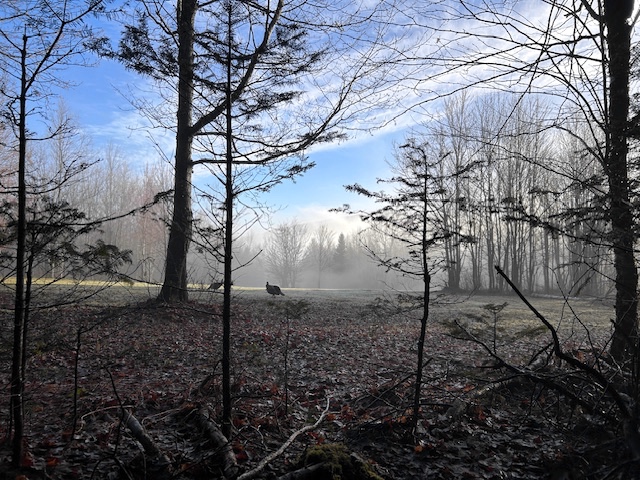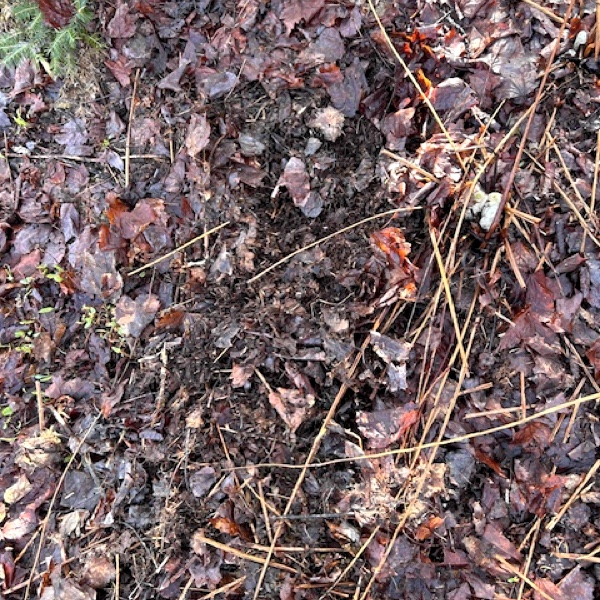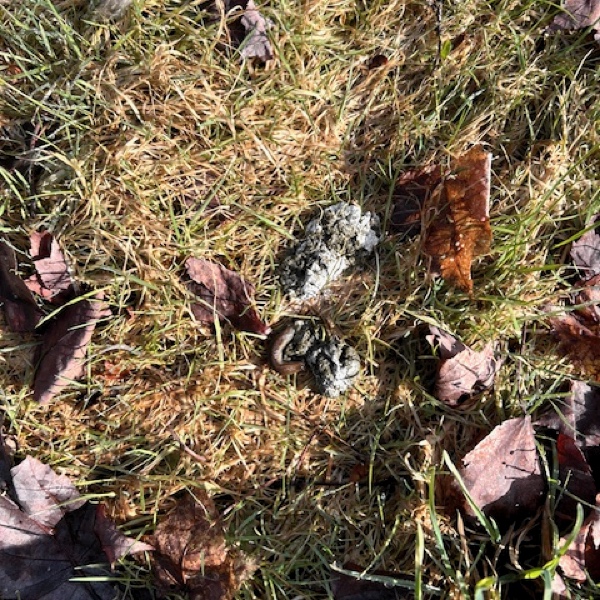
Learning Opportunities
These are just a few of the things that make hunting wild turkeys challenging but immensely rewarding when it all works out. The least little thing that is overlooked or goes wrong can provide the opening to alert the turkey to our presence, therefore resulting in an unsuccessful hunt when the bird finally realizes that "something here isn't right". Occasionally hunters can get away with a small mistake, but most of the time, our mistakes end up in a long walk back to the truck ... alone. Wild turkeys can be unforgiving if there's some sloppy hunting going on.

What a spot this was to setup in. Only turkey hunters know the pleasures of watching and hearing the turkey woods wake up on an early spring morning.

A fresh turkey scratching, but there were many older scratchings as well, indicating that turkeys had been frequenting this area quite often.

One of the several piles of turkey scat that I found in this area. It's a great spot and will be part of our hunts from now on.
My early morning setup was on the edge of a ridiculously beautiful meadow, near the top of a slight slope. If turkeys were going to come in, they would presumably (another point - never "presume" with turkeys ... they often come from directions that are unexpected) be coming uphill at me, giving me a slight advantage. My resting spot was perfect, tucked away in a dark patch of small spruce, only twenty yards or so away from my hen and jake decoys. I commenced calling periodically, hoping that my sweet sounds would coax an unsuspecting gobbler to come my way.
It didn't take too long, a half hour or so, before I started hearing turkey sounds coming my way from down the hill. Sharp cuts and cackles that only a hen would make emanated from below my position, and she was suddenly there, walking right in to my spread. She lounged and primped her feathers, just feet away from my decoys, making contented sounds all the while. I particularly noted the sharp cuts she made on her approach - something that seemed like a good thing to add to the calling repertoire.
A short time later, two more birds came in to the spread, from the left side of me, but these again were hens, and one of them seemed to be the boss. She made a beeline for my hen decoy and commenced to peck at it in the head. Exceedingly relaxed, they hung out by the spread for a while, and then trundled off to scratch and feed in the woods nearby. Unfortunately, no males came in to the decoys, but the amount of scratchings (new and old) and scat found in the area confirmed that it was a good place to setup the decoys in the future.
My other learning opportunity came later that same morning, as I "walked and talked" across a hardwood ridge, calling periodically down a slope where I had seen birds earlier in the week. It didn't take too long to get a distant gobble after one of my calls from high up on a knob. It may have been faint, but my ears did not deceive me. I moved closer, across the ridge, making calls and the unmistakable answer from a male turkey erupted from down below.
I moved quickly to a position where I stayed on the top side of a little knob, where if a turkey came in I would have a realistic shot should the bird poke it's head over the top in search of me. In a short time, the gobbles were much closer - so much closer that I adjusted my position to face to my left (where I thought the bird would appear), instead of my original straight downhill position. As it would turn out, the bird came from downhill on my right, suddenly appearing from a direction that I had not anticipated, and was not prepared for.
It was a big, mature longbeard, brilliant in the late morning sun. When I moved slightly to try to get a shot, he spotted me and knew something was amiss. A few putts of alarm and a quick change in direction sealed my fate - the turkey was quickly on his way to safety and I was left wondering why I had shifted my sitting position prior to the gobbler's arrival on the scene. No, I don't believe in taking rushed shots out of desperation - perhaps that bird can be called in another day when he has forgotten about our previous encounter ...
